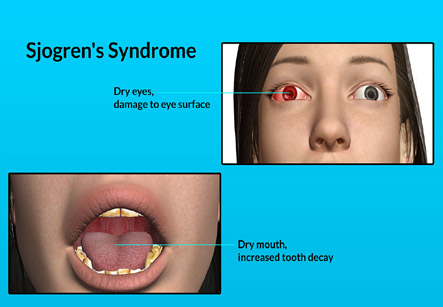Sjogren’s syndrome
Introduction
Sjogren’s syndrome is a disease of the immune system of human body. The immune cells that normally fight infections become deranged and destroy glands that produce tears and saliva. It predominantly affects women aged around 40. The commonest presenting feature is generalized unpleasant and painful dryness. Dryness predominantly affects mouth and eyes. The disease may affect organs like kidneys, lungs, liver, pancreas etc. Diagnosis is established on the basis of clinical examination and series of laboratory investigations and other diagnostic procedures. Treatment of Sjogren’s syndrome is primarily symptomatic and supportive.
Iranian scientists have moved to the forefront in embryonic stem cell research, according to a recent joint study by Harvard University and the Massachusetts Institute of Technology

Treatment
At present there is no definite cure of Sjogren’s syndrome. Recent advances made in the field of stem cell therapy have prompted the researchers to evaluate its efficacy in Sjogren’s syndrome. Stem cell therapy has been directed to preserve and restore normal functions of gland. The patients who may be benefited from stem cell therapy should be carefully selected. Stem cells have the potential for developing into any desired cell of the body. They may be obtained from blood or bone marrow in an adult or from umbilical cord bleed in a baby after its birth. These cells are usually grown in the laboratory into their desired form before being injected into the patient.
Detailed and large scale studies are warranted to establish the exact role of stem cell therapy and its efficacy and safety in Sjogren’s syndrome.
The exact status of the role of stem cell therapy is still in its infancy. One report Harvard Medical school suggests stem cells collected from spleen have got potential to be differentiated various types of cells including cells of the salivary gland. Another American study suggests, twenty six patients of Sjogren’s syndrome, who were non-responsive to conventional treatments, were treated with stem cell therapy. Patients remained symptom free for more than four years.
Further in-depth studies are being conducted at present. One such is study is under way in National Institutes of Health Clinical Centre, USA. This study is evaluating ability of stem cell therapy to restore function of salivary gland. One French study has reported that stem cell therapy has been able to arthritis of multiple joints associated with Sjogren’s syndrome.
All these evidences suggest the possible role of stem cell therapy in Sjogren’s syndrome. Detailed and large scale studies are warranted to establish the exact role of stem cell therapy and its efficacy and safety in Sjogren’s syndrome.